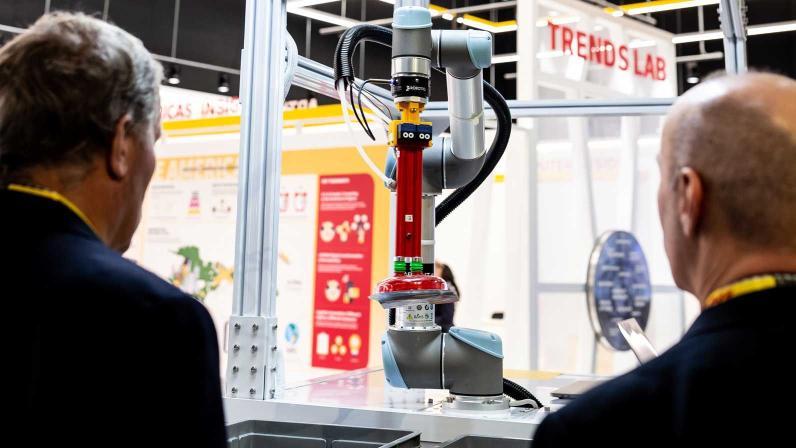
A piece-picking demo at DHL’s Innovation Center. | Credit: DHL
DHL this week opened its 28,000-square-foot Americas Innovation Center in Rosemont, Ill., a suburb of Chicago. This is DHL’s third innovation center, joining the initial center in Cologne, Germany and another in Singapore.
DHL’s U.S.-based Innovation Center showcases the latest in logistics technology, including robotics. DHL has been using robotics to enhance its logistics operations, especially mobile robots for materials handling applications. For example, DHL has piloted and deployed robots from 6 River Systems, Fetch Robotics, Locus Robotics, Mobile Industrial Robots, Seegrid and Vecna Robotics.
“The DHL Innovation Center Grand opening was impressive,” Daniel Theobald, Founder and CEO of Vecna Robotics, told The Robot Report. “I really admire the approach DHL has taken with its commitment to open innovation. They set a good example for the rest of us to follow. When we work together as an industry to solve common problems, everybody will prosper more.”
The Robot Report attended a private tour of the Innovation Center and several DHL facilities in and around Chicago. We spoke to Matthias Heutger, Global Head of Innovation and Commercial Development at DHL, to learn how DHL is currently using robots and what improvements need to be made for robotics to have an even bigger impact on its logistics capabilities.
How does the DHL Innovation Center push forward the logistics robotics industry?
We talk about robots, but what does it actually mean? If we get customers here, they get to see robots here and say, “I can really see how that will fit into my operations.” That’s different from just going to a customer site and presenting about Locus Robotics.
We then do a two-day workshop on innovation projects to address the customer’s challenges. We look at which technologies we’re using that could help solve their challenges. Then we do pilots with them. It also creates social acceptance of robotics. You come here and touch and feel the robots, you realize they’re not that dangerous. It helps overcome some of those perceptions.
How would you categorize the current state of warehouse robotics?
We are on the verge of the rise of robots in warehousing. The majority of work done in warehouses, 70-80%, is still manual. There’s a huge opportunity right now, especially driven by e-commerce. We are not able to cope with the volume, neither in delivery or in fulfillment. We need to find new ways of doing it.
In the past, the problem was that automation wasn’t flexible enough and was too cost-intensive. Now with collaborative robots, increased computing power and lower costs, we see a huge investment in implementing robotics in our warehouses.
For example, we have one site in the US with 100 LocusBots [from Locus Robotics]. It gives us tremendous improvements and helps us cope with volumes. The robots are relatively simple. But now that we’ve done it, we know how to deploy them better and will be replicating this at other sites.
How does DHL evaluate what robots are best for warehousing operations?
It always comes down to a few things. Locus and Fetch Robotics, for example, started as robotics companies for logistics. From the very beginning they focused on logistics applications. This is different from other robotics companies that start somewhere and they also now do logistics.
It’s also important to find a partner we can actually work with. Typically when a potential partner comes in, the product as it is doesn’t work 100%. We have to iterate with them. In many of these mobile robots, the navigation is a big part of it. The hardware is very similar – the robot itself, the sensors – so it’s about the software. In some of our operations, we don’t have many orientation points. Navigation software is key.
Related: Shopify acquires 6 River Systems for $450M
Warehouse automation startup 6 River Systems was acquired by Shopify for $450 million. And in 2012 Amazon purchased Kiva Systems for $775 million. Would DHL ever buy a robotics company?
“Would we ever?” is always a hard question. I wouldn’t personally suggest to do that. I would not bet everything on one technology or one company. Right now there are so many companies out there, and they all have strengths and weaknesses. We need to work with different technologies and providers because we have different use cases.
If you only have one use case, and maybe Shopify has that, then it might work – this is the best solution, let’s go for it. But we have so many different applications, processes, products and setups that we want to be unbiased to what technology we’re going to use.
What is more important for DHL is to understand how to integrate robotics. So would I invest in robotics integration services? Probably.
How would you like to see robots continue to improve?
The mobile robot companies that are moving materials are on a good track. For them it’s now about more precision and faster navigation.
Picking is clearly the holy grail, particularly piece-picking. We have some solutions, but the speed just isn’t there. We did a challenge last year, but the technology is still slow. The human hand is very difficult to replicate.
Piece-picking is an area that needs the most development. It’s not mature enough yet to really deploy. They need to be faster at recognizing the pieces and grabbing them. There are so many different pieces, some are hard and some are soft, we intuitively know how to grab them with our hands. We need better AI to make the right conclusions and have the physical arm to grab the pieces as fast as a human hand, which is pretty fast.
How is DHL evaluating drones and autonomous vehicles?
It’s a matter of timing and application. For drones, we started with cycle counting in warehouses. We have drones on a leash right now as indoor navigation for drones is not good enough right now. That might change with 5G, but drones can’t really navigate well if they don’t have GPS in terms of height of the shelf. We put the drones on leash on a self-driving robot to do cycle counting. It’s a work around. But we do see drones in niche applications like disaster areas.
For fully self-driving vehicles, the first thing you’ll see is self-driving trucks. We’re piloting platooning already in the UK. The first truck is still manned, then a couple of unmanned trucks follow behind. Then you will see certain highways with fully autonomous trucks. Last-mile delivery is tricky because of the regulations and obstacles around it.
It’s coming, but just like drones, self-driving vehicles needs to make sense for us. If you want to deliver thousands of packages in one neighborhood, it makes more economic sense to send one van instead of drones. If you single packages in remote areas, it makes more sense to send a drone. Technology isn’t the question anymore.
Filed Under: Warehouse automation, Automotive, The Robot Report, Wireless • 5G and more, Robotics • robotic grippers • end effectors

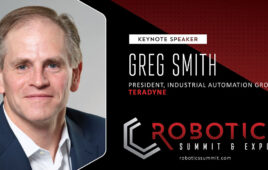
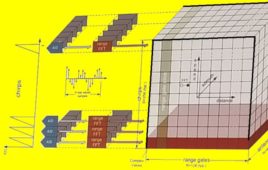
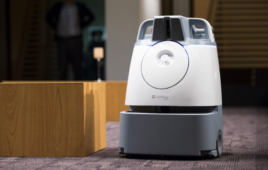
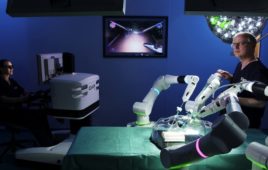
Tell Us What You Think!